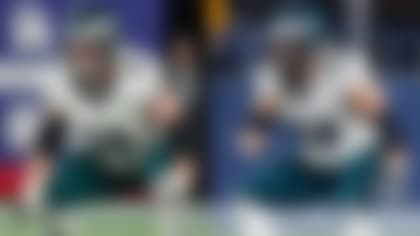The season is only five weeks old, but the murmurs are growing in Foxborough after watching the Patriots' high-powered offense struggle this season. A unit that was expected to light up scoreboards has been out of sync for most of the year, and the unfulfilled expectations have led many to point the finger at quarterback Tom Brady.
While the former league MVP has put up solid numbers (61.4 percent completion rate, 1,344 yards, six touchdowns, two interceptions), he has been uncharacteristically inconsistent from the pocket and his up-and-down play has been a disappointment to those expecting the Patriots' offense to pick up where it left off in 2007, the last time Brady was at full strength.
"He is definitely not the same player that he was in 2007," said an AFC scout who has extensively studied Brady as his team prepares to face the Patriots later in the season. "He played at such an elite level during that season that you expect him to make every play, but he hasn't been able to do that this season."
Brady missed 15 games in 2008 after tearing the ACL in his left knee in the season opener, and the nine–year veteran is still adjusting to mental and physical obstacles that typically accompany such a devastating injury.
Whereas Brady could be counted on to deliver knockout shots from the pocket in the past, he has routinely missed open receivers in critical moments this season and the team's offense has bogged down as a result. Though some of the rustiness exhibited by Brady is to be expected, there is growing concern that he may not return to the elite level he previously occupied. The league has seen numerous quarterbacks who suffereD similar injuries fail to regain their pre-injury confidence and poise in the pocket, and even those that successfully return undergo a bit of a rough patch.
Carson Palmer, who suffered a career-threatening knee injury during the 2006 playoffs on a hit from the Steelers DT Kimo von Oelhoffen, needed to play almost two full seasons before regaining his form. While Palmer's return was affected by other injuries, his uncomfortable presence in the pocket led to sub-par performances in the seasons following his injury.
Even Peyton Manning got off to a slow start in 2008 after missing an entire training camp while recovering from summer knee surgery. However, Manning shook off the rust near midseason and finished so strong in the second half that he earned his third league MVP award.
A bounce-back performance from Brady of that magnitude would be a welcome sight to those who expected Patriots' offense to pick up where it left off in 2007.
During that record-breaking season, the Patriots led the league in total offense (411.2 yards per game), scoring offense (36.8 points per game) and passing offense (295.7 yards per game). Brady served as the catalyst by tossing a league-record 50 touchdown passes while compiling a gaudy 117.2 passer rating on the way to tallying eight 300-yard games on the year.
Fueled by the big play, the Patriots led the league with 57 completions over 20 yards and ranked second with 15 pass plays that covered 40 yards or more. Wes Welker finished as the league co-leader in receptions (112) and Randy Moss broke the league record with 23 touchdown receptions.
However, the Patriots offense hasn't been nearly as explosive in 2009, and there are a myriad of reasons why the unit has failed to perform up to expectations. Perhaps none more important than the change of personnel over the last year.
"While most of the focus has been on Brady and his play after the injury, people need to realize that the cast around him has changed, and that is having the biggest impact on (the Patriots') performance," the AFC scout said.
The departure of former offensive coordinator Josh McDaniels has robbed the unit of a fearless play-caller. McDaniels masterfully orchestrated the Patriots' spread attack by constantly varying his personnel and formation packages, and seemingly had an effective counter to the various tactics that defensive coordinators would use to stymie New England's attack. From the use of the deep ball to the effective use of the wide receiver screen package, the Patriots tormented foes with their versatility, and McDaniels had the wherewithal to push the right buttons at the right time to exploit opposing defenses.
McDaniels' departure has put the onus on Bill Belichick to tweak the offensive system to fit Brady's strengths, and the long-time head coach has the arduous task of rebuilding the offense while dealing with critical injuries at the skill positions. Welker missed two games while dealing with a knee injury, and running back Fred Taylor has been sidelined indefinitely with an ankle injury.
The 2007 version of the Patriots featured speedsters Jabar Gafney and Donte Stallworth playing prominent roles in the passing game. While neither is regarded as an elite player, they were good enough to exploit favorable matchups against the opposition's third- or fourth-best corner. When defenses opted to load up against Welker or Moss, Brady routinely torched them by connecting to Gafney or Stallworth on big plays over the top. The explosive duo's penchant for delivering big plays made the Patriots' aerial attack seemingly impossible to stop.
In New England's current lineup, rookie Julian Edelman, Joey Galloway and Sam Aiken are the complementary weapons. While Galloway has been regarded as an impact player throughout his career, the 38-year old wideout no longer strikes fear in defenses. He has repeatedly failed to come up with plays when called upon (he had critcal drops against the Jets and Falcons), and his inability to deliver has landed him on the inactive list the past two weeks.
Edelman filled in admirably for Welker during his two-game absence, but he lacks the explosiveness to take advantage of single coverage opposite Moss and Welker. Though he has 15 receptions on the year, his average of 9.7 yards per catch hasn't been enough to attract extra attention from defenses.
In addition to getting little contribution from the supporting cast in the passing game, Brady has received virtually nothing from the team's rushing attack. The Patriots rank 20th in rushing yards (101.0 per game), and their 3.6 yards per carry is currently the league's eighth-worst mark.
Although Taylor briefly provided a spark with his 105-yard rushing performance against the Falcons, the lack of a solid running game has forced the team to use a one-dimensional attack with the success of the Patriots' offense riding on Brady's right arm. Brady has passed at least 32 times in each of New England's five games, including more than 40 attempts in each of the team's first three games. While the Patriots have won using that formula in the past, the pass-happy approach may not be best suited for Brady while he's working back from his injury.
The lack of a running game has contributed to the team's red-zone woes. Although the Patriots rank as the league's ninth-best offense (361.4), they average only 20.6 points per game, 18th in the league, and their inability to effectively run the ball is partially to blame. Without a consistent threat in the backfield to force eight-man fronts, the Patriots routinely see two-deep or umbrella coverage inside the 20. The combination of soft coverage and a condensed field yields few opportunities for Brady and Co. to attack. Thus, the Patriots have the second-most field goal attempts in the league (16) and have tallied six field goals covering fewer than 30 yards on the season, meaning they have been stopped repeatedly inside the 20-yard line.
The Patriots' explosive offense has also been diffused by defensive game plans that are closely mimicking the scheme used by the Giants in Super Bowl XLII. In pulling off the stunning upset, the Giants used a mixture of five- and six-man blitz pressures with conventional four-man rushes to disrupt the rhythm of the Patriots' passing game. In addition, New York made a commitment to eliminate the deep ball to Moss. With the Giants' tactics resulting in the suffocation of Brady and the Patriots' offense, defensive coordinators have increasingly used similar strategies when facing New England in 2009.
The Jets and Broncos both opted to use a mixture of pressure and coverage to make Brady uncomfortable in the pocket while keeping a safety over the top of Moss to limit his effectiveness. The ploy has been an overwhelming success; Moss has just five receptions over 20 yards and the prolific touchdown-maker has been held to only one score through five games. Though Welker has been able to repeatedly shake free against the bend-but-don't-break approach, he has been held to a paltry 8.7 yards per catch and has yet to produce an "explosive" play this season. Without any threat in the passing game capable of delivering a big play, the Patriots' offense no longer packs the punch that made it a fearsome unit only two seasons ago.
The reported demise of the Patriots' offense has been attributed to Brady's injury, but the budding cynicism brewing in New England may be an overreaction given the team's exceptional record (21-2) when Brady, Moss and Welker take the field as starters. While they may never return to the video game-like explosiveness of 2007, the Patriots are only a sensational performance away from finding the elusive rhythm and chemistry needed to set the league ablaze.
With upcoming games against a pair of leaky pass defenses (Tennessee and Buccaneers) before heading into their bye, Brady and his mates could be dangerously close to finding the groove that has eluded them this season.





